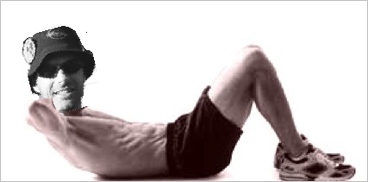 | ||
| ||||||||
Dan Burger shows off his highly developed six-pack abs, the result of crunches, twist-ups and Photoshop. By Dan Burger Have you ever wondered why your back starts to ache during a long, hard skate? More than likely the reason is your core conditioning ... or lack thereof. Inline skating puts a heavy load on your core muscles (the muscles of your abdomen and lower back), especially when you're tucked in the low skating position. If you're muscles are flabby, they can't take the strain. What Is the Core? The core consists of four layers of muscle:
The rectus is what we call the six-pack. When it contracts, it brings your rib cage and hip bone closer together. The internal and external obliques run diagonally and perpendicular to each other, and thus act to twist the upper body in relation to the lower body. Most activities that we do daily have some twisting — walking, running, swimming, skating. The transversus muscle runs horizontally across the abdominal wall, and acts to push in and up on internal organs, adding to core stability much like a girdle. This muscle is probably the most neglected of the four, and should be held taut while doing exercises targeting the other muscles. Look around ... or look down ... you will see neglected tummies everywhere. It's worse with guys, partly because of our taller, more muscled upper bodies, and partly because of our preferred beverage: beer. Our neglected tummies put an extra load on our lower backs. The result is the backache that often starts after several miles of hard skating. The fix is easy. Just do some core work on most days of the week, followed by some stretching to help with recovery and flexibility. Remember the greater your muscular endurance, tone, and range of motion, the longer you will be able to maintain good form. And the longer you can maintain good form, the longer you can skate at top speed. The importance of core conditioning increases with distance. It really hits home in a 100K or Athens to Atlanta. KISS - Keep It Simple, Smarty-pants The easiest way to keep your core in good shape is to practice two simple movements: the crunch and the twist. But you've got to do them right to get the full benefit. How to Do the Crunch Lie on your back with knees bent and feet flat on the floor. Tuck your tail slightly to keep your back from arching. With your hands touching the top of your head (or tickling your ears or folded across your chest), raise your chest straight up while holding your belly button in. Concentrate on shortening the distance between your hips and ribs. Only your head and shoulders need to come off the floor. Hold briefly and then roll back down smoothly. Try to feel each vertebra as it flexes and extends. Do the movement slowly with mindful intent. (Put your mind in your muscle!) I call this my "nose-up" crunch because when I do it, I keep my nose pointed at the ceiling. Do three sets of 15-30 a day. "Nose-ups" build your six-pack. The next step is to build your obliques (see sidebar: What is the Core?), which is a simple matter of modifying the crunch into what I call a "twist-up." How to do a Twist-Up Lie on your back with your knees bent and feet on the floor. But this time, cross one foot over the other. If you cross the right over the left, put your left hand in the crunch position, but lay your right arm straight out to the side. Then, when you rise up, twist toward the right, keeping your right arm and shoulder glued to the ground. Do three sets on on the right and three sets on the left. Crunch and Twist-up Tips
Breathing is important. Try to remember to breath out on the up movement and in on the return. Also, it is important to try not to pull on your head with your hands and to keep your spine "neutral." Your lower back need not be pressed into the floor, but it should remain in contact with the floor throughout. Other Core Building Exercises Crunches and twists aren't the only exercises you can do to build your core. Swimming is very helpful, and you can also do hip raises, bicycles, bridges, V-ups, planks, etc. Just remember to contract your transversus muscle with whatever exercise you do. ...
Related reading: • Skate Tip of the Week Archive
...
Copyright © 2008 Inline Planet | ||||||||


 Dan Burger, a former inline racer, has a B.S. in Exercise Physiology and Biomechanics and is a Certified Acupressure Massage Therapist.
Dan Burger, a former inline racer, has a B.S. in Exercise Physiology and Biomechanics and is a Certified Acupressure Massage Therapist.